Global property adviser, Knight Frank, has launched a roadmap to ensure that businesses are able to safely re-enter the workplace once lockdown sanctions have lifted, whilst ensuring the safety and wellness of employees and continuing to decrease the spread of COVID-19.
Knight Frank’s Strategic Workplace Consultancy team developed the roadmap based on current accepted re-occupancy procedure being trialled in Asia and supported by the US government. This includes social distancing with the office, and extended working from home on a part time basis to allow reintegration into the workplace.
The roadmap is designed to support occupiers in five clear areas: understanding their employee base, reviewing the employee/ customer journey within the workplace, evaluating social distancing options, determining occupancy impact and developing protocols.
The roadmap, which helps businesses determine best practice for re-occupying offices, identifies two categories of change that will need to occur in order to safely re-enter the workplace.
The first is behavioural changes, ensuring that strict protocols such as clear desk policies are applied, and that social distancing is possible within the workplace.
The second is environmental changes including increased air flow, changing HVAC filters or enhancing cleaning regimes.
Neil McLocklin, Head of Strategic Consultancy at Knight Frank, said: “With lockdown now confirmed for at least a further three weeks the severity of the current situation could not be more apparent. Business will be keen to return to the office as soon as possible, but their staff will need assurance that it is a safe environment to do so. This will mean we come back to a very different office, with perhaps every other desk vacant to allow social distancing, and very different behaviours. I regularly have video calls with colleagues in China and seeing them wearing face masks in the workplace highlights the different work environment we will be returning to. Defining and agreeing the new policies, protocols and cleaning regimes is critical now, so businesses are prepared for the return and staff are reassured that the workplace will be safe.
“The World Health Organisation (WHO) is advising that social distancing should continue as workforces return, a model that is currently being adopted in China. However, adapting office environments to best facilitate collaboration, whilst also ensuring safe working practices and limiting the risk of COVID-19 is a difficult challenge. We have developed this framework to provide an important first step for businesses to safeguard against the spread of coronavirus. We will need to adapt to a new normal, at least for the foreseeable future, which combines both the importance of collaboration, social interactions and conducting business whilst mitigating fear and protecting the workforce.”
In order to encourage environmental and behavioural change in the workplace Knight Frank has created clear ‘overlays’ – clear steps and floorplan guidance – to aid businesses in assessing the risk and capacity issues.
The COVID-19 ‘Risk Overlay’ identifies the spaces that present with the highest risk of contamination and creates a roadmap for how to reduce surface transmission through increased protocols. High risk areas are identified as those that people share as part of their normal working day which could potentially increase the potential of human-to-human transition. These could include lifts, break or café areas, washrooms, printers, libraries, coat cupboards, or vending areas.
The COVID-19 ‘Capacity Overlay’ provides options on how to use space to accommodate the workforce in the office with distancing recommendations. Businesses are encouraged to develop an occupancy strategy. A comparison can then be drawn between the size and functions within an office and the number of people that are expected to be in any given office space. This can then determine which areas can be used safely. Key areas of the office which will need to be evaluated and adapted will be conference rooms, phone rooms, workstations, open breakout areas, cafeterias.
The roadmap has been created in a way that can be easily adapted. Every office and office culture are unique, therefore businesses must individually create their own strategies to implement environmental and behavioural chance that will reinforce safety measures ahead of workforces re-occupying buildings.















